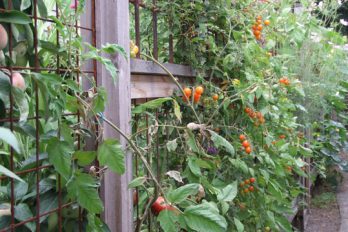Dogwoods, even dog roses, are welcome in the garden, but what about real four-legged dogs? “Horrors!” you say. “Big, clumsy creatures that dig, scratch, pee and poop. Not on my heuchera!”
It doesn’t have to be that way. Yes, some dogs do rampage through the garden. So do some kids. (And let’s not even contemplate what cats do to fresh earth.) The similarity between dogs and kids isn’t superficial. Canadian canine expert Dr. Stanley Coren of the University of British Columbia says dogs are about equal in intelligence to a two-year-old child.
Our four-legged friends do have some animal instincts, but we smart humans can make that work for us. Keep these four points in mind, and you’ve got the foundation for a great dog-human-garden relationship.
- Dogs are pack animals. They like to know their place and have a leader to follow.
- Dogs are creatures of habit. Once they get in a groove, they tend to stay in it.
- Dogs are clean in their toilet habits. They don’t like to mess in their homes.
- Dogs can learn – with time, patience and persistence on the part of their owners.
Leading and learning
Dogs are naturally social and accustomed to obeying the alpha or boss dog. So unless you want an obnoxious toothy terror running around, you have to be the alpha in your little pack. Doggy minds are simple, so make it very clear what you expect and what isn’t allowed. One owner of a showplace garden uses the same “no chew” command in the garden that she uses in the house. And she’s never lost a plant to him, she says proudly.
Of course, my friend spends lots of time with her dog, and he’s not left unsupervised in her storybook garden of roses, clematis and other perennials. That’s what most happy dog-loving gardeners say. They spend time with their animals, teach them to obey and the magical human-animal bond develops.
Lane White, head trainer at Who’s Walking Who obedience school in Toronto, explains: “My dogs have a great deal of respect for me. I have a relationship with my dogs and that’s not something you can teach other people. You can teach the commands, but relationships are ongoing. A good dog owner is training his dog 100 per cent of the time in what’s appropriate, what’s expected. It comes from repetition, and you must be consistent every time.”
Happily, dog training in recent years has become an enjoyable activity. Grim orders aren’t the style de jour. Instead, today’s owners use happy voices and food rewards to manipulate their dogs into doing the right thing. And once the beasties – bless their furry little hearts – discover what gets the goodies, they keep on doing it.
Habit forming
With the right treats and several short training sessions a day, your dog can learn to sit even at a distance from you. He’ll learn to back away from things, stop barking, stop digging and stay out of the Japanese painted ferns (or whatever you treasure). Unfortunately, habits work the other way, too. Let him make a misstep a few times without correction, and it becomes a habit that’s hard to break.
Dogs like straight lines, for example, so if you have lovely curved paths, walk through them with him close beside you a few times. Help him remember by putting up visible barriers at first – low lattice fencing or even white-painted rocks. If you have especially precious or valuable plants, protect them for a time with wire fencing or tomato cages.
If you spend time outdoors with your dog, he’ll come to think of the garden the way he thinks of your home indoors – that means less doggy doo scattered around. Many gardeners like to set aside a toilet area for their pets. Do it by taking the dog there every single time he needs to relieve himself, perhaps giving a command like “potty.” Praise for performance and keep the area clean and you’ll have a dog trained for life in a couple of months.
Troubles and remedies
Yellow spots Playfully called female dog spot disease, these lawn spots are made by males too. They are actually a sort of fertilizer burn from nitrogen in the urine. Folk remedies abound, but one tested solution is to flush the area with water within eight hours. You can use commercial patching formulas or feed your dog canned food (its higher water content dilutes the urine concentration). But your best bet is to train your dog to a potty area.
Digging Digging is usually caused by canine boredom. Dogs are bright critters, and they need something to occupy them. The easiest solution is lots of exercise – outside the garden. “A tired dog is a happy dog” is an old trainer’s maxim. Teaching your dog tricks, indoors or out, will also focus his attention and tire him out. Use bits of food to lure him into a spin in front of you and he’ll soon learn the command “twirl.” If you have space, throwing a ball is easy on you and a good run for him. Likewise, you can always try distracting him with favourite toys.
Barking Dogs are territorial and will bark at passing people and other dogs if they can see them. It’s a frustrating situation for everyone. Avoid it by using solid fences that your dog can’t see through. Distracting him with another command (“sit”) and a reward also helps prevent the habit from taking hold.
Dogs and their behaviour are endlessly fascinating, and behaviourists are learning new things every day. The payoff for all the effort is when you see a secure, contented dog grinning under a flowering apple tree – a picture you’ll carry in your heart forever.
Photo: Nutmeg66, Flickr




